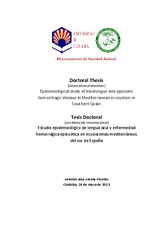Estudio epidemiológico de lengua azul y enfermedad hemorrágica epizoótica en ecosistemas mediterráneos del sur de España

Ver/
Autor
Arenas-Montes, Antonio José
Director/es
Arenas-Casas, AntonioGarcía-Bocanegra, Ignacio
Editor
Universidad de Córdoba, Servicio de PublicacionesFecha
2013Materia
Lengua azul (LA)Virus de la lengua azul (VLA)
Enfermedad hemorrágica epizoótica (EHE)
Orbivirus
Andalucía (España)
Ecosistema mediterráneo
Ungulados
Detección molecular
METS:
Mostrar el registro METSPREMIS:
Mostrar el registro PREMISMetadatos
Mostrar el registro completo del ítemResumen
La lengua azul (LA) y la enfermedad hemorrágica
epizoótica (EHE), son dos enfermedades emergentes y reemergentes
de declaración obligatoria, causadas por virus
pertenecientes al género Orbivirus. Ambas virosis infectan
generalmente a rumiantes domésticos y silvestres, siendo los
mosquitos del género Culicoides, los vectores principalmente
implicados en la transmisión de estas enfermedades,
particularmente C. imicola, considerado como el principal
vector competente en la cuenca mediterránea. En los
últimos años, la circulación del virus de la LA (VLA) ha sido
muy intensa en Europa, especialmente en España, donde se
ha detectado circulación de tres serotipos diferentes (1, 4 y
8). Por el contrario, la circulación del virus de la EHE (VEHE)
no ha sido confirmada en Europa hasta la fecha, si bien, la
presencia del virus en países norteafricanos determinan un
riesgo evidente de entrada en el continente europeo.
Los principales objetivos de este trabajo han sido: 1)
determinar la prevalencia y distribución espacio-temporal
del VLA en las poblaciones de ungulados silvestres en los
ecosistemas mediterráneos, así como, establecer los
principales factores de riesgo potencialmente implicados en
la epidemiología del VLA en estas especies; 2) Evaluar la
posible circulación del VEHE en Andalucía; y 3) describir la... Bluetongue (BT) and epizootic hemorrhagic disease
(EHD) are two emerging and re-emerging notifiable diseases
caused by viruses belonging to the genus Orbivirus. Both
viruses usually infect domestic and wild ruminants, being
Culicoides midges the main competent vectors involved in
the transmission of these diseases. Among the different
species of culicoides, Culicoides imicola is considered the
main species implicated in the transmission of both
orbiviruses in the Mediterranean Basin. During the last
decade, the BTV circulation has been very intense in Europe,
especially in Spain, where three different serotypes has been
detected (1, 4 and 8). However, EHDV circulation has not
been detected in Europe to date, although the presence of
this virus in northern Africa is a risk for the introduction to
European countries.
The main objectives for this thesis were: (1) to
determine the spatio-temporal distribution of BTV
prevalence in wild ungulate populations in Mediterranean
ecosystems from southern Spain, as well to establish the
main risk factors potentially involved in the epidemiology of
BTV in these species; (2) to evaluate the possible EHDV
circulation in Andalusia: and (3) to describe the spatiotemporal
distribution and abundance of culicoides species in
Andalusia.
The study was carried out in Andalusia during the...
